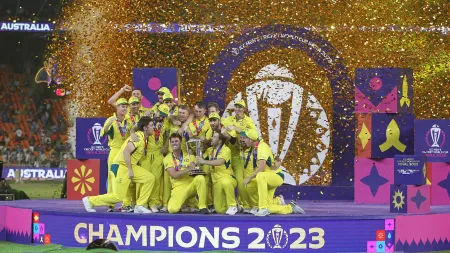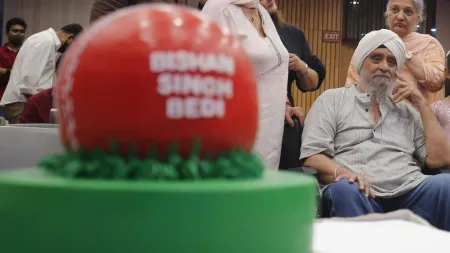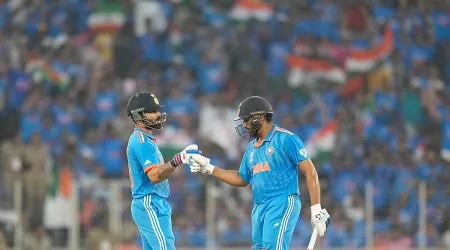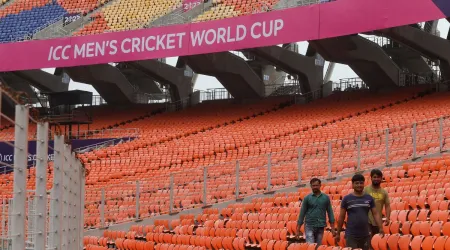- India
- International
Sumit Nagal: The monk who sold his Ducati
Taking a set off Roger Federer at US Open might have been the highlight of Sumit Nagal’s year. But what defines 2019 for the young Indian tennis talent is the new-found maturity and poise in his game, as he remains grateful for staying injury-free and forging ahead with his furious forehand, finds The Indian Express
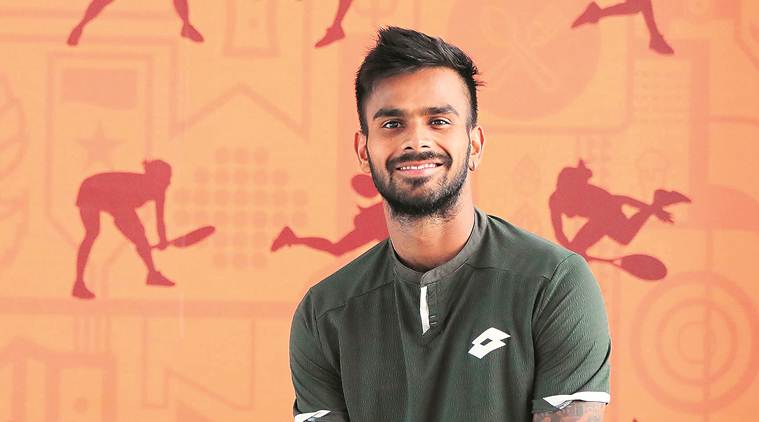 Sumit Nagal started the year grimacing from a shoulder problem and a low world rank that made it a struggle to gain entry into tournaments. Now he’s closing in on breaking the top 100.
Sumit Nagal started the year grimacing from a shoulder problem and a low world rank that made it a struggle to gain entry into tournaments. Now he’s closing in on breaking the top 100.(Express photo by Ashish Kale)
A boy, not yet 10, takes his place in a queue at the baseline of a tennis court in a government school in New Delhi, awaiting his turn at the top of the line. He doesn’t know much about this game, but finds a similarity with his favoured sport cricket — hit ball with racquet. But when his turn comes, he misses.
The ball he’s played his cricket with, at home, or in the neighbourhood streets of Jhajjar in Haryana, was a rubber ball that was heavy and didn’t bounce much. This yellow furry tennis ball though jumps, and bounces well over his head.
No matter. He walks back to the back of the queue and awaits his turn again. The exercise goes on for a while, and he estimates that he hit perhaps just one or two shots in around 30 attempts.
A few years later, the boy, Sumit Nagal, now 13, is on a court in Canada and coming to the end of a practice session. But there’s one more drill his coach Bobby Mahal has for him. It’s an exercise that the youngster would be forced to do at the end of every practice session for the next four years.
“(Mahal) would feed 30-40 balls to my forehand and said hit it as hard as possible,” Nagal recalls. “Flat and hard, use the legs, full racquet-head speed, full body power. No drop shots allowed, nothing cute or fancy, no fooling around. Just full-blooded shots. He said he wanted me to develop a forehand because a big forehand is going to take a lot of time to learn.”

In August 2019, Nagal walks onto another court, the fabled Arthur Ashe Stadium — the world’s largest tennis arena — set to take on a certain Roger Federer. It is a match he could never have hoped to win, but by no means would he bow out without putting up a fight. His game is all about grinding, and he brought that to court against the 20-time Grand Slam champion, along with the forehand that is arguably the biggest among Indian players. Federer was impressed.
“He actually does a really good job, especially on the inside-out, how he gets around. That was impressive,” the former world no 1 would say after winning the match in four sets.
As the year nears conclusion, so does Nagal’s first full season in the four years he’s been playing on the professional circuit. The 22-year-old has exceeded all expectations, as he rose from the threat of becoming an injury-ravaged tennis nomad to being the most talked about Indian singles player this year. He started the year grimacing from a shoulder problem and a low world rank that made it a struggle to gain entry into tournaments. But now he’s reached a career-high 127 and is closing in on breaking the top 100.
***
The promenade that overlooks the outer courts of the Balewadi Tennis Stadium in Pune has become longer now for Nagal. A walk across the length of it takes more time for him, as he’s stopped for photographs and autographs. He laps it up, smiling politely in every selfie, and courteously signing caps, notebooks, racquets alike. He’s here for the KPIT Pune Challenger, his last event of the season, and he’s enjoying all the fandom he’s been getting in his first tournament in India since his rise up the ranking ladder.
This reception though is a far cry from what transpired when he was last at the very same venue, at the Tata Open Maharashtra back in January.
“I came here but didn’t get in,” he says, sitting in the room now marked ‘VIP lounge’ that was meant only for competing players during India’s only ATP 250.
He had come at the time, with his kitbag close at hand, hoping for a wild-card entry into the same tournament that saw him, in 2018, make his tour level main draw debut. But his rank of 340 was not good enough for a spot even in in the qualifiers. A week later he’d drop down to 361 and the struggle to get into tournaments anywhere in the world became all the more brutal. And expensive.
“(There were) financial problems because if I was getting entry on Friday for tournaments that start on Monday, then the last minute tickets were getting expensive,” he says. “The first five tournaments I played this year, every ticket I bought was over $1,000 one-way which would normally be at least half the price.”
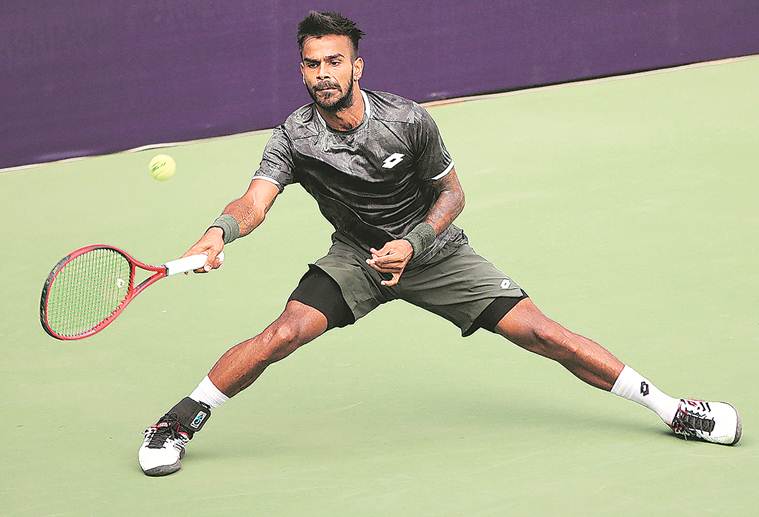 As the year nears conclusion, so does Nagal’s first full season in the four years he’s been playing on the professional circuit.
As the year nears conclusion, so does Nagal’s first full season in the four years he’s been playing on the professional circuit.
But Nagal was desperate to play. The promise of better days ahead outweighed the high costs of travelling. He was struggling to get into tournaments, but he had started preparing himself for the grind in the right way, with a coach and trainer. Once he started getting into tournaments in the first few months, wherever it was in the world (Vietnam, Germany, Canada, Chile, Italy, the United States…) Nagal knew things would only improve.
***
In early 2017, two years after he won the junior Wimbledon double’s title, Nagal was reeling with a shoulder strain. Surgery was an option, a rather risky one, but instead he opted for a longer recovery. The pain did go away, but he needed almost two years to get fit. And by the time he started the 2019 season, a few niggles were there, but more daunting was the mental fear of the shoulder flaring up again.
“Earlier when I had this problem I would always think twice before hitting a ball. There was always a thought that ‘what if I do this and it starts to hurt?’” Nagal says. “I don’t have that thought now so I can play more freely. I can serve more freely. I can hit more freely and that’s definitely one of the good things.”
A part of the freedom comes from him having the confidence in his own body. The other part comes from having a calm and clear mind. He realised that he needed to take the mental aspect of the game as seriously as the physicality. And so in April, he started working with a psychologist to help him channel his on-court aggression.
“It’s just more about knowing myself, realising, and analysing the mistakes,” he says. “People say to stay in the moment, but I don’t think that’s possible. How can you forget it when it just happened seconds ago?
“So now what I do with the (psychologist) is try to find the reason for why I miss a ball. Just analysing. It’s about watching videos and realising what I was feeling like, how my mind was during the match and what I feel like now seeing it again. It’s realising that, ‘oh, why did I get mad if I hit a cross court and the ball came back and I had no option. Why am I getting mad?’
“And also working on the nervousness. Everyone gets nervous, it’s normal. But now I’ve learnt to channel it elsewhere. Maybe I’d run more, use my legs more, focus on putting some more height on the ball. Basically put that nervousness somewhere else except the outcome.”
Channelling that nervousness elsewhere made room for the remarkable composure Nagal put on display when playing Federer, in front of 21,000 odd fans, in the world’s largest tennis stadium, and then winning the first set against the Swiss maestro, that too in his first ever Grand Slam main draw match. Again, Federer was impressed.
“I guess maybe how he handled the moment. Never easy to come out and play your best. Even though it’s kind of what you live for, you dream about, playing on the big stage. So I think he did that very well,” Federer said about Nagal’s mentality.
Working with a psychologist is one thing, a major upswing in Nagal’s season came with his working with coach Sascha Nensel — who has worked with former world no 4 Nicolas Kiefer and former WTA world no 9 Julia Goerges — and trainer Milos Galecic, who has previously worked with former India no 1 Somdev Devvarman.
“Working with Sascha and Milos, it’s the environment they bring,” Nagal states. “All three of us have a really good, fun relationship. Sascha is always in a good mood, we joke around and the body language is always happy. If I’m happy, I always look forward to go on court or do the fitness, and you always want to work harder. That is very important to me.”
Nagal has been staying ‘happy’ for quite a while this year, and as a result, he’s spent a good amount of time on court going deep into tournaments. He’s made it to semi-final or better of eight ATP Challengers this year, going through to the final twice and winning the title in Buenos Aires. Along the way, he’s beaten former world no 17 Albert Ramos-Vinolas and former world no 24 Martin Klizan, along with making it to the main draw of an ATP 500 (Hamburg) for the first time in his career. Then in August, he played seven sets in the US Open qualifiers to set up that memorable clash against Federer.
He remembers getting a lot of messages from friends and family after that match. The ones that sticks out though were those from his old friends in the junior academy group who have all turned professional now.
“‘Hey, good job,’” Nagal recites, “‘you’re finally coming back. We can feel it.’”
***
Nagal remembers talking to his father only a day after the Federer match. Amidst the wave of emotion, he recalls his father saying the words: “Today, you have made us very proud.”
It was only then that the youngster remembers his own mood lightening up. He owes his tennis career to his father, Suresh Nagal, even if he didn’t know what he was doing when he first started playing the sport.
“When I was young, I was always out of the house playing something or the other, either tag, or hide-and-seek, or cricket. Anything,” says the Jhajjar-native. “Dad started to think that I’m wasting my time because, well, you can’t do much being good at hide-and-seek when you grow up. And he wasn’t even interested in cricket. It had to be tennis.”
There was no word of protest from Nagal as his father, a teacher at a government school, signed him up for the academy in New Delhi. After the initial struggle with judging the bounce of a tennis ball, Nagal started showing some promise in the game. And once he started hitting with confidence, Suresh decided it was time to work on fitness.
“Somehow, and I don’t know till date who told him this, Dad always thought fitness was important. He didn’t have the knowledge and fitness work meant just running, doing lots of sprints and movement. But he made sure I did it,” Nagal says. “He’d come home in the evening and I’d be ready. So from around six in the evening to 9:30 at night, we were out doing fitness for at least two years. Who would have thought then that my game would be shaped around it?”
The fitness was in place, but Nagal still wasn’t the brightest junior coming up when Mahesh Bhupathi came to Delhi to hold trials for the Apollo Academy in 2007. Nagal wasn’t keen to go though, especially when his father fell sick on the morning of the trials. But he still travelled the 20-odd kilometres to Delhi with his mother, impressed the 12-time Grand Slam champion and earned a spot in the academy.
But when the academy shut down, the financial strain prompted the youngster to quit the game. Until two months later, he got a call from Bhupathi.
“He asked me if I’d play if he were to sponsor me. Of course, I said ‘yes.’”
Under Bhupathi’s guidance, Nagal travelled to Canada and later on to Germany, on the way to becoming a talented counter-puncher with a killer forehand. And Nagal would have it no other way, for it’s the slugfests that he enjoys the most.
“When you win comfortably, you can’t take much from it because maybe you played too well and the opponent couldn’t do much. You don’t get those often,” he says. “But when you win the ugly ones, the dogfights, you know that you were mentally there and you really feel good. Those are the biggest wins, and I feel very confident in those, the dogfights.”
***
In Pune, Nagal’s run ends in the quarterfinal after a straight-sets loss to compatriot Ramkumar Ramanathan. But the responsibility on his shoulders is bound to increase in the coming season. He’s made his mark this year, in the first season of his four-year career that hasn’t been cut-short by injury. The biggest challenge for next year though will be to prove that he can maintain the ranking points he earned in 2019, and go even further.
In the next few weeks, he will return to the Davis Cup fold to spearhead the Indian team, as the team prepares to compete for a World Group Playoff spot against Pakistan.
At the same time, he’s set his own targets for the next year.
“The first target is to break into the top-100. And after that it is to make the cut for the Tokyo 2020 Summer Olympics,” he says. “I’ll be chasing that. I think the cut-off for the Olympics comes in July. So I’ve got six-seven months to get as many points as possible.”
Over the last year, Nagal has changed from the short-tempered, injury-prone promising youngster he was when he first came out onto the tour. He’s matured, both on and off the court.
When he was 16, he had asked his father to buy him a Ducati, a powerful and expensive motorcycle, for his 18th birthday. He remembers his father saving up for around two years to get him the gift. But the rigours and constant travel on tour did not allow the youngster much time to spend on his treasured vehicle. Soon enough, he saw it practical to sell it.
“It was just standing there. Then it didn’t make sense. At the end I probably asked for it because I was young blood, hot blood, you know. You just want to drive fast, ride fast,” he says. “And I’m so happy that, even though I enjoy riding and driving, I’m out of that zone where I want to driver faster. Now I’m in the slow lane, chilling, listening to music, enjoying the car, enjoying the environment.”
The struggles with injury have brought about a greater appreciation for the time he spends on court. And that is the most important thing to him. But he’s still working his way up, and he’s doing it the way he loves to.
Running hard, hitting hard, playing with a free mind.


















